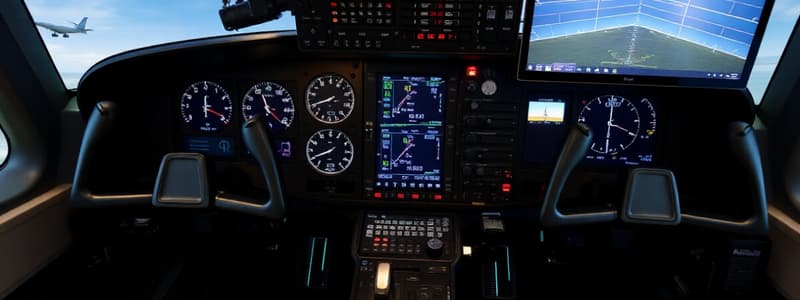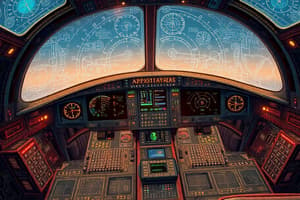Podcast
Questions and Answers
What is the main function of the Flight Director (FD)?
What is the main function of the Flight Director (FD)?
- To autonomously control the aircraft's speed.
- To directly control the aircraft's altitude without pilot input.
- To assist pilots by providing pitch and roll steering commands. (correct)
- To manage fuel consumption during flight.
What is the primary purpose of the Auto Throttle (AT) system in aircraft?
What is the primary purpose of the Auto Throttle (AT) system in aircraft?
- To control the aircraft's yaw movements.
- To automate navigation during flight.
- To stabilize directional oscillations.
- To manage automatic throttle for speed and thrust. (correct)
Which inputs does the Flight Director (FD) utilize for its computations?
Which inputs does the Flight Director (FD) utilize for its computations?
- Only GPS data.
- ADC, compass systems, vertical gyros, and VHF navigation radios. (correct)
- Radar altimeter data and flight logs.
- Weather data and pilot manual inputs.
What is unique about the Control Wheel Steering (CWS) mode of the Autopilot (AP)?
What is unique about the Control Wheel Steering (CWS) mode of the Autopilot (AP)?
Which phase of operation does the Auto Throttle automatically set N1 thrust based on environmental factors?
Which phase of operation does the Auto Throttle automatically set N1 thrust based on environmental factors?
How does the yaw damper stabilize directional oscillations in swept-wing aircraft?
How does the yaw damper stabilize directional oscillations in swept-wing aircraft?
Which operational mode of the Flight Director (FD) is focused on maintaining altitude?
Which operational mode of the Flight Director (FD) is focused on maintaining altitude?
What feature does the yaw damper utilize to modify its response sensitivity?
What feature does the yaw damper utilize to modify its response sensitivity?
What does the Roll Channel in the Autopilot (AP) manage?
What does the Roll Channel in the Autopilot (AP) manage?
How does the Flight Director display commands?
How does the Flight Director display commands?
In which mode does the Flight Director use roll adjustments to guide the aircraft?
In which mode does the Flight Director use roll adjustments to guide the aircraft?
Which component of the Autopilot is responsible for controlling yaw?
Which component of the Autopilot is responsible for controlling yaw?
What kind of stabilization does the yaw damper specifically address in swept-wing aircraft?
What kind of stabilization does the yaw damper specifically address in swept-wing aircraft?
What is the primary purpose of the Auto Throttle?
What is the primary purpose of the Auto Throttle?
Which component ensures feedback on throttle positions in the Auto Throttle system?
Which component ensures feedback on throttle positions in the Auto Throttle system?
During an approach, what does the Flight Director do when transitioning to ILS?
During an approach, what does the Flight Director do when transitioning to ILS?
What is the primary function of the disengagement protocols in an aircraft?
What is the primary function of the disengagement protocols in an aircraft?
Which components are responsible for translating computed commands into physical adjustments of control surfaces?
Which components are responsible for translating computed commands into physical adjustments of control surfaces?
In what scenario would the specialized 'Turbulence Mode' in autopilot be most beneficial?
In what scenario would the specialized 'Turbulence Mode' in autopilot be most beneficial?
What role do the enhanced visual displays serve in the flight deck commands?
What role do the enhanced visual displays serve in the flight deck commands?
What feature allows pilots to regain control of the aircraft in emergencies?
What feature allows pilots to regain control of the aircraft in emergencies?
Flashcards
Vertical Inputs
Vertical Inputs
Sensors provide altitude and attitude data to the flight control system.
Actuation
Actuation
Motors or hydraulic systems translate commands into physical control surface changes.
Integrated Protections
Integrated Protections
Flight envelope safeguards prevent the aircraft from exceeding its limits, ensuring safety.
Autopilot Detailed Logic
Autopilot Detailed Logic
Signup and view all the flashcards
Autopilot Disengagement Alerts
Autopilot Disengagement Alerts
Signup and view all the flashcards
Flight Director (FD)
Flight Director (FD)
Signup and view all the flashcards
Flight Director (FD) Inputs and Computations
Flight Director (FD) Inputs and Computations
Signup and view all the flashcards
Flight Director (FD) Modes
Flight Director (FD) Modes
Signup and view all the flashcards
V-Bar Display
V-Bar Display
Signup and view all the flashcards
Autopilot (AP)
Autopilot (AP)
Signup and view all the flashcards
Control Wheel Steering (CWS)
Control Wheel Steering (CWS)
Signup and view all the flashcards
Command Mode
Command Mode
Signup and view all the flashcards
Roll Channel of Autopilot
Roll Channel of Autopilot
Signup and view all the flashcards
What is Auto Throttle (AT)?
What is Auto Throttle (AT)?
Signup and view all the flashcards
What is the purpose of Auto Throttle?
What is the purpose of Auto Throttle?
Signup and view all the flashcards
What is a Yaw Damper?
What is a Yaw Damper?
Signup and view all the flashcards
How does a Yaw Damper work?
How does a Yaw Damper work?
Signup and view all the flashcards
What is a Flight Director?
What is a Flight Director?
Signup and view all the flashcards
What are the main modes of an Autopilot system?
What are the main modes of an Autopilot system?
Signup and view all the flashcards
What is Beam Capture in autopilot?
What is Beam Capture in autopilot?
Signup and view all the flashcards
What are the types of servo systems used in aircraft?
What are the types of servo systems used in aircraft?
Signup and view all the flashcards
Study Notes
Automatic Flight Control Systems (AFCS)
- Flight Director (FD): Provides pitch and roll steering commands for smooth altitude/heading changes. Inputs include ADC, compass, vertical gyros, and VHF navigation. Modes include Heading, VOR/LOC, Approach (manual/automatic), Altitude Hold, Go-Around, and Back Course. Specific functions like VOR/LOC use course deviation and roll attitude for adjustments. Displays include V-Bar (combined pitch/roll) and Split-Cue (independent left/right and up/down). Commands are limited (±12° pitch, varying roll limits), and sensitivity adjustments for narrow glideslopes.
Autopilot (AP)
- Function: Electronically controls pitch, roll, and yaw, reducing pilot workload.
- Operational Modes: Control Wheel Steering (CWS) where pilot inputs processed to assist flight controls, and Command Mode for fully automated heading/altitude control based on AFCS inputs.
- Components: Roll Channel (aileron/spoiler control), Pitch Channel (elevator/stabilizer control), and Yaw Channel (rudder). Servo systems include electro-pneumatic and electro-mechanical/hydraulic for varied precision and redundancy.
- Advanced Features: Glideslope deviation attenuation for smooth ILS transitions. Integration with Low Range Radio Altimeter for precision.
Yaw Damper
- Purpose: Stabilizes directional oscillations (Dutch Roll), especially in swept-wing aircraft prone to dihedral effects.
- Operation: Utilizes rate gyros, yaw damper computer, and hydraulic PCUs to dampen yaw oscillations via rudder deflections. Operates independently of pilot input.
- Key Features: Limited rudder movement (2-5°) and gain programming for adjusting response sensitivity depending on flight conditions. Can integrate with pilot rudder input for coordinated turns.
Flight Director and Autopilot Integration
- Modes/Functions: Heading, VOR/LOC, Approach, Altitude Hold, Beam Capture.
- Inputs: Vertical (altitude/attitude) incl VG, AHRS, IRU, ADC. Lateral (directional) incl Gyros, compass, VHF.
- Actuation: Servo motors or hydraulics execute computed commands to physical control surfaces.
Summary of FD Commands
- Displays: Combines pitch and roll guidance for intuitive adjustments during all flight phases.
- Modes: Supports diverse scenarios, including Back Course and Go-Around.
- Error Correction: Steering commands dynamically address deviations from the flight path.
Autopilot Operational Enhancements
- Detailed Logic: Advanced interlock systems ensure reliable operation.
- Specialized Modes: Turbulence Mode for improved response during unstable conditions, and Altitude Select for precise transition to target altitudes.
- Safety Features: Disengagement alerts, warnings, and override mechanisms for manual control in emergencies.
Studying That Suits You
Use AI to generate personalized quizzes and flashcards to suit your learning preferences.
Related Documents
Description
Test your knowledge on Automatic Flight Control Systems (AFCS), including the Flight Director (FD) and Autopilot (AP) functionalities. This quiz covers operational modes, command inputs, and display features that enhance navigational precision. Ideal for students and professionals in aviation or aerospace engineering.




